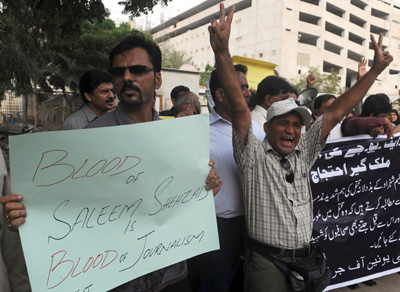Yesterday marked the 10th anniversary of the disappearance of Wall Street Journal reporter Danny Pearl in Karachi on January 23, 2002. On February 21 of that year, a video of his beheading was released. In the wake of the judicial inquiry into the murder of journalist Saleem Shahzad, veteran Pakistani journalist Mazhar Abbas has taken a comparative look at the two investigations with this article from the most recent magazine section of The News on Sunday.
As time passes, more Pakistani journalists are taking a closer look at the report of the inquiry into Shahzad’s murder at the end of May 2011. Last week I pointed to an Umar Cheema piece in The News that raised several questions that should be answered, including the possibility of another culprit, beyond the widely held belief that government security agencies were behind Shahzad’s beating death. The inquiry was, not surprisingly, inconclusive: “No culprits named in Shahzad investigation, media reports” was CPJ’s January 11, 2012 headline. It was a prediction we had made in June 2011 in “Justice for Saleem Shahzad? We’ve seen this before…“
As Abbas points out in Sunday’s article, “The comprehensive report gives some useful suggestions and recommendations, including legislation about the accountability of intelligence agencies, but fails in fixing the responsibility of the murder due to lack of evidence.” He then goes on to contrast the investigation into Shahzad’s death with that of the killing of the American Pearl in 2002. Pearl’s death was the only case of the death of a journalist that led to a full police investigation, a trial and convictions, though the process in retrospect looks flawed.
It is good that, unlike the deaths of so many other Pakistani journalists, that of Saleem Shahzad has remained a topic of discussion and hopefully further investigation by journalists, if not the police. And once they get to the bottom of that one, there are scores of others that remain to be resolved — 42 journalists who have been killed for their work, plus 14 others in which CPJ has not been able to confirm the motive. In virtually all of these cases, there has been little beyond a perfunctory police investigation. With that record, Pakistan ranks as the sixth most deadly country for journalists since we began keep regular records in 1992. And in 2010 and 2011, Pakistan ranked as the world’s most deadly country for journalists.
